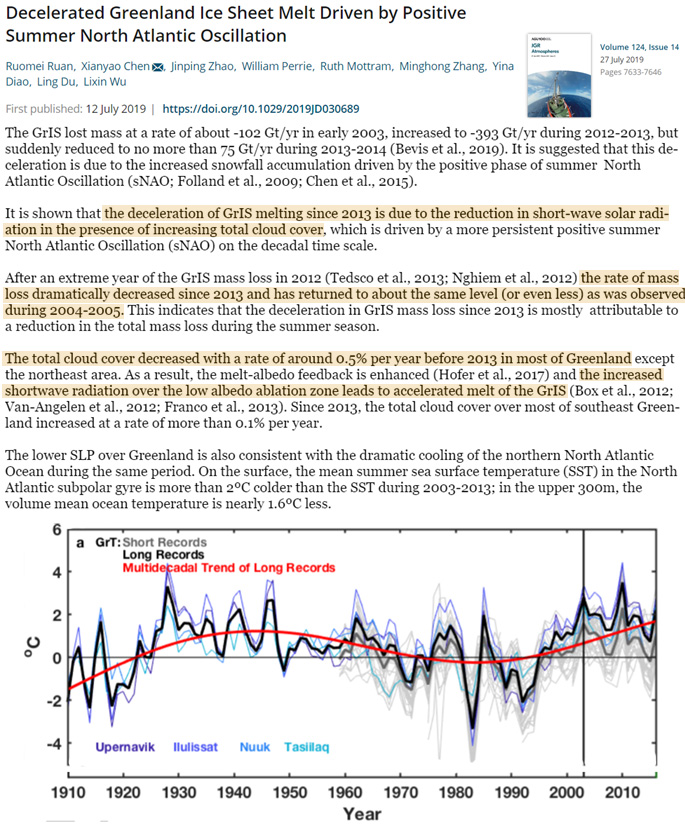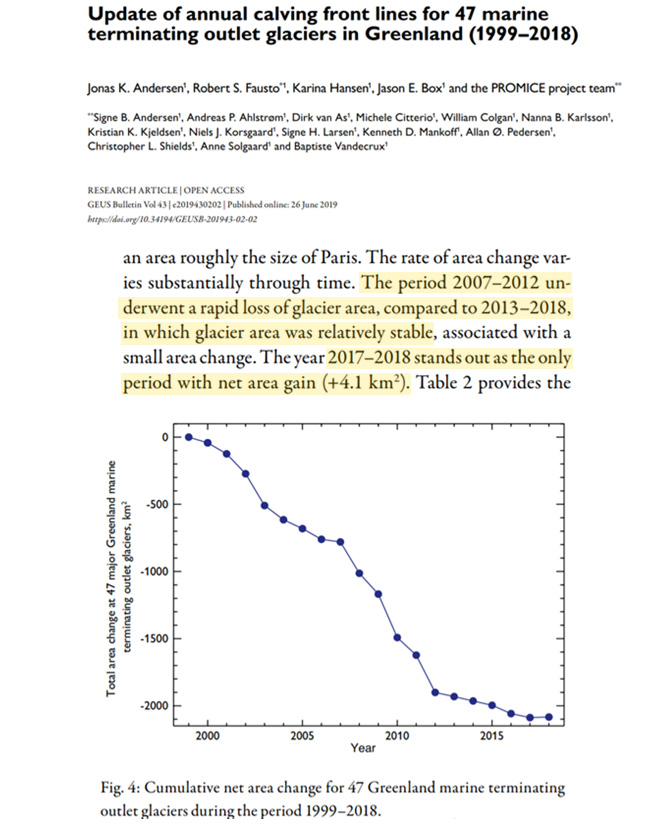Greenland’s ice sheet mass losses have significantly decelerated since 2013 – a reversal from the rapid retreat from the 1990s to 2012 driven by cloud forcing and the NAO (Ruan et al., 2019). The post-2013 “relatively stable” ice sheet even gained mass during 2017-’18 (Andersen et al., 2019).

Ruan et al., 2019
Decelerated Greenland Ice Sheet Melt Driven
by Positive Summer North Atlantic Oscillation
“The GrIS lost mass at a rate of about -102 Gt/yr in early 2003, increased to -393 Gt/yr during 2012-2013, but suddenly reduced to no more than 75 Gt/yr during 2013-2014 (Bevis et al., 2019). It is suggested that this deceleration is due to the increased snowfall accumulation driven by the positive phase of summer North Atlantic Oscillation (sNAO; Folland et al., 2009; Chen et al., 2015).”
“It is shown that the deceleration of GrIS melting since 2013 is due to the reduction in short-wave solar radiation in the presence of increasing total cloud cover, which is driven by a more persistent positive summer North Atlantic Oscillation (sNAO) on the decadal time scale.”
“After an extreme year of the GrIS mass loss in 2012 (Tedsco et al., 2013; Nghiem et al., 2012) the rate of mass loss dramatically decreased since 2013 and has returned to about the same level (or even less) as was observed during 2004-2005. This indicates that the deceleration in GrIS mass loss since 2013 is mostly attributable to a reduction in the total mass loss during the summer season.”
“[T]he total cloud cover decreased with a rate of around 0.5% per year before 2013 in most of Greenland except the northeast area. As a result, the melt-albedo feedback is enhanced (Hofer et al., 2017) and the increased shortwave radiation over the low albedo ablation zone leads to accelerated melt of the GrIS (Box et al., 2012; Van-Angelen et al., 2012; Franco et al., 2013). Since 2013, the total cloud cover over most of southeast Greenland increased at a rate of more than 0.1% per year.”
“The lower SLP over Greenland is also consistent with the dramatic cooling of the northern North Atlantic Ocean during the same period. On the surface, the mean summer sea surface temperature (SST) in the North Atlantic subpolar gyre is more than 2ºC colder than the SST during 2003-2013; in the upper 300m, the volume mean ocean temperature is nearly 1.6ºC less (Fig. 6). The cooling of the ocean is not only helpful for the atmospheric configuration over the Greenland, but also favorable for the reduction of mass loss due to warmer water intrusion into the marine-terminated glaciers, though the latter process explains only around 30-50 Gt of the total mass budget of the GrIS (Zwally et al., 2002; Box et al., 2009; Tedstone et al., 2013).”
Andersen et al., 2019
Update of annual calving front lines for 47 marine
terminating outlet glaciers in Greenland (1999–2018)
“Currently, the mass loss from the Greenland ice sheet is the largest Arctic contributor to global sea-level rise (van den Broeke et al. 2009, 2017; Box et al. 2018).”
“The period 2007–2012 underwent a rapid loss of glacier area, compared to 2013–2018, in which glacier area was relatively stable, associated with a small area change. The year 2017–2018 stands out as the only period with net area gain (+4.1 km2).”






The only way to prevent this is to mandate electric vehicles…
https://i1.wp.com/www.powerlineblog.com/ed-assets/2019/08/Screen-Shot-2019-08-06-at-1.42.56-PM.png?w=1160&ssl=1
https://twitter.com/Sherloc10168034/status/1151956062964203521
All to mitigate the imagined effects of imaginary excess warming, by pretending we can have any effect on that warming.
Who dreams this nonsense up?
https://thabto.files.wordpress.com/2012/10/wile-e-coyote-super-genius.jpg
“Where glaciers reach the sea, icebergs calve and float away, carrying within them clots of debris including large boulders. This debris drops to the seafloor when the ice melts and may accumulate in an environment where currents are weak and where thin-bedded or laminated deposits are being laid down. Ancient deposits of laminated shales with sporadic large stones, or clots of unsorted debris, may therefore be properly interpreted as the result of rafting. If these drop-stones in turn are large and angular and are composed of mixed rock types carried from great distances, and especially if some of them are glacially faceted and straited, we can infer that the rafts were thick icebergs from calving glaciers rather than thin sheets of shore ice or sea ice. Root mats and kelp holdfasts may also raft oversized stones and debris to environments of laminated deposition but are not so efficient as ice. In the Precambrian, however, plants did not yet exist, so ice rafting is confidently inferred.”
https://www.nap.edu/read/11798/chapter/8#78
[…] Read more at No Tricks Zone […]
@Kenneth
Do you have any papers that correlate ice loss and ice gain?
Specifically, if the ice sheet increases in one year, I would expect that at some time after the increase that more ice would be discharged by calving to the ocean.
Recently lots of mass has been added.
https://www.iceagenow.info/wp-content/uploads/2018/12/Greenland-Ice-Sheet-SMB-2018-768×825.png
It wouldn’t surprise me if calving would increase, while the melt rate might not change much. Any refs on the total mass balance? Thx
https://www.sciencedirect.com/science/article/pii/S0921818104000360
“[I]t is found that the effect of increased precipitation on Antarctica dominates over the effect of increased melting on Greenland for the entire range of predictions, so that both polar ice sheets combined would gain mass in the 21st century. … Combining these results with the long-term background trend yields a 20th and 21st century sea-level trend from polar ice sheets that is however not significantly different from zero.”
Thank you.
And also…
“…the process for the Green-land ice sheet is found to be different, with decreased precipitation rather than increased runoff as the major source of the mass loss.”
Hysterically shouting “It’s not melting. It’s not melting,” just doesn’t convey urgency and panic – sort of like shouting “chocolate” in a crowded theater.
Here’s the PDF that came up in a search on the title.
https://faculty.fgcu.edu/twimberley/EnviroPol/EnviroPhilo/Modelling.pdf
(Sometimes one can find the articles for free, which is good, because I don’t have the, in this case $40.00, to access all the articles I’d like.)
PS – Still a lot of clueless fanatics out there…
http://joannenova.com.au/2019/09/predatory-climate-deniers-immediate-threat-to-our-children-tim-flannery-rants-but-admits-his-colossal-failure/
As I posted elsewhere, what appears to be science dying on closer inspection appears more like a process of molting. Unfortunately though, sometimes it takes uncomfortably long to shed it’s last skin, though.
[…] https://notrickszone.com/2019/09/16/2-new-papers-scientists-report-a-rapid-deceleration-of-greenland… […]
[…] https://notrickszone.com/2019/09/16/2-new-papers-scientists-report-a-rapid-deceleration-of-greenland… […]
[…] https://notrickszone.com/2019/09/16/2-new-papers-scientists-report-a-rapid-deceleration-of-greenland… […]
[…] 2 New Papers: Scientists Report A Rapid Deceleration Of Greenland Ice Sheet Melt Since 2013 […]